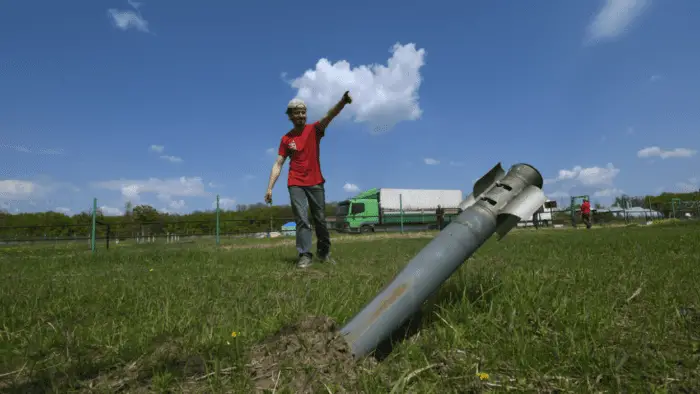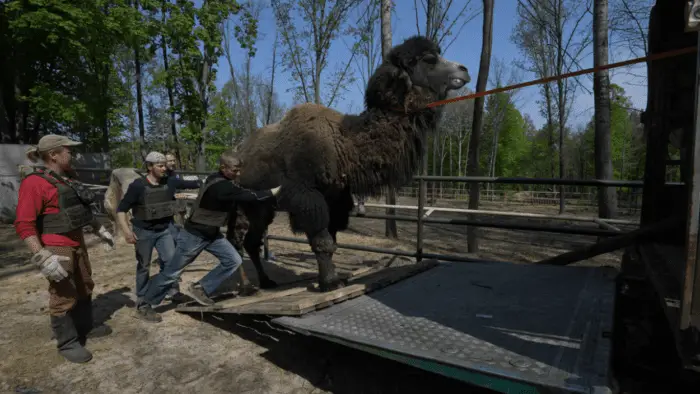Documentaries about the ongoing Russian invasion of Ukraine have served as powerful testimonies for non-Ukrainian audiences about the horrific perils of living in a warzone. Lately, documentaries depicting direct civilian experiences have garnered significant mainstream attention, most recently with the awards success of Msystlav Chernov’s 20 Days in Mariupol, the recipient of this year’s Academy Award for Best Documentary Feature—a PBS-produced journalistic display of the terror and dire conditions of those hiding from Russian fire. Equally vital now seem to be narrowed-down, specified perspectives of the conditions that Ukrainian citizens endure in their attempts to escape Russian-bombed areas of Ukraine and restore whatever it is they have left. Over time, it seems that films like Joshua Zeman’s Checkpoint Zoo may very well serve to be among the first demonstrations of that documentarian specification in action, electing to portray the events of a rescue mission for animals trapped in a Ukrainian zoo as the Russian invasion grows closer to its doorstep.
Checkpoint Zoo‘s intended impact is made readily apparent through the incredibly tense way that it opens; through footage of the volunteers and workers sedating various predators before hauling them onto a truck with explosions going off in the background, a rushed operation that requires even the physical efforts of the cameraman filming all of this. Over the course of the ensuing few minutes, the context for such a dire situation immediately becomes clear—these animals have been in incredible danger ever since the onset of the Russian invasion, which forced all workers of Feldman Ecopark to leave the area and leave the animals unattended. Checkpoint Zoo, as a result, is a documentation of the Ukrainian rescue efforts for these animals, and the incredibly dangerous risk it took to transfer them to safety while the dangers of Russian soldiers and bombs escalated with each passing day.

Among the miracles of documentaries like these (including A Rising Fury and A House Made of Splinters) is the fact that the footage featured in them even got captured in the first place. That’s not immediately apparent when it comes to the earlier portions of Checkpoint Zoo; most of it is a mix of news footage, viral civilian footage, and hand-filmed documentation from volunteers in the initial stage of what grows to become a rescue plan. Immediately following the mass exodus of Feldman Ecopark’s employees, the main source of sustenance that the animals receive is through the assistance of volunteers near the area who reach out to the Ecopark, many of whom film themselves at work. Even then, there lie sizable risks in terms of handling dangerous predators that put them in significant danger, even unfortunately killing one volunteer in the process of doing so.
But it steadily becomes clear that the sense of duty that the Ecopark’s volunteers and workers possess is what allows them to continue their work, even as the Russian invasion grows ever closer to their territory, and their shelling attacks begin to directly endanger the animals. Checkpoint Zoo‘s refusal to work solely in the realm of the retrospective is what also lends it so much power—like the documentaries of its ilk that preceded it, it’s the immediacy of its miraculously captured footage from both dedicated cameramen and from the workers’ phones that gives it so much power. Among the film’s most terrifying moments is when the workers attempt to transfer dangerous predators while under the watch of a Russian drone, which then promptly triggers a shelling attack that sabotages their plans, frantically signaling to each other that they need to tear down the cages and move the big cats out as soon as they can.
Also noteworthy is just how cohesively Checkpoint Zoo traces the ways through which the plans of the Ecopark’s workers and employees go awry and are adapted to over the course of several months. With the danger of shelling constantly at their doorstep, the inevitability of such danger makes abundantly clear just how much determination they had to muster in order to push through and save every animal in the process. First, the animals are transferred over to Kharkiv’s own Ecopark; then, when it becomes clear that Russia is only about to escalate its presence there, the animals are then moved to the estate of Oleksandr Feldman, one of the most prominent governmental figures supporting the Ecopark, who morphs his entire mansion into a de facto Noah’s Ark by selling nearly all of his worldly possessions.

Their troubles don’t even stop there; the need for these animals to move to not just a location where they’re even more safe, but also better tended to and looked out for then requires another kind of transfer completely, one that itself nearly runs them out of options financially and logistically. It’s easy for so many of the details within a story like this to get lost in the edit, especially given the sheer quantity of people who participated in such a bold rescue operation, but among the greatest triumphs of Zeman’s filmmaking is just how gracefully and accessibly every moving part of this story is balanced in present-day interviews, on-the-ground footage, archival videos, and so on. Formally speaking, it’s an exciting mix that keeps the pace of the story fresh, only further accentuating the real-life shock and awe mustered by its most thrilling high-tension moments.
There’s a deep optimism to the fact that the human spirit of everyone who worked under intense pressure and danger to rescue these animals from the encroaching Russian invasion did so out of both an empathetic instinct to protect the Ecopark’s animals, and their desire to preserve something valuable to a country they remain completely set on defending. Checkpoint Zoo thrives most as a portrayal of profound selflessness from people unceasingly placed under threat of serious danger, yet still being willing to risk their lives for the sake of a common cause they understand to be greater than themselves. It’s a film willing to run the full tonal gamut, ranging from a heartwarming instance where one volunteer’s footage of him driving kangaroos in a truck goes viral to the point of appearing on Stephen Colbert’s show, to a harrowing moment of searing grief following a terrible loss so intense it left me breathless from just how unwaveringly it was depicted. The fact that nearly anything here was filmed at all is an achievement on behalf of all involved who took on-the-ground footage; the cohesive narrative plotting through which each event within this story is traced is another; the striking spirit of perseverance that this movie embodies may still very well be the most potent among them.



